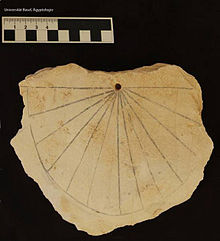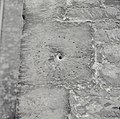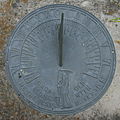History of sundials

A sundial is a device that indicates time by using a light spot or shadow cast by the position of the Sun on a reference scale.[4] As the Earth turns on its polar axis, the sun appears to cross the sky from east to west, rising at sun-rise from beneath the horizon to a zenith at mid-day and falling again behind the horizon at sunset. Both the azimuth (direction) and the altitude (height) can be used to create time measuring devices. Sundials have been invented independently in every major culture and became more accurate and sophisticated as the culture developed. [5]
Introduction
A sundial uses
History
Ancient sundials

The earliest household clocks known, from the archaeological finds, are the
An early reference to sundials from 104 BCE is in an assembly of calendar experts.[14]
The ancient Greeks developed many of the principles and forms of the sundial. Sundials are believed to have been introduced into Greece by Anaximander of Miletus, c. 560 BCE. According to Herodotus, Greek sundials were initially derived from their Babylonian counterparts. The Greeks were well-positioned to develop the science of sundials, having developed the science of geometry, and in particular discovering the conic sections that are traced by a sundial nodus. The mathematician and astronomer Theodosius of Bithynia (c. 160 BCE to c. 100 BCE) is said to have invented a universal sundial that could be used anywhere on Earth.[citation needed]
The Romans adopted the Greek sundials, and the first record of a sundial in Rome is in 293 BCE according to
- the hemicyclium of Berosus the Chaldean: a truncated, concave, hemispherical surface
- the hemispherium or scaphe of Aristarchus of Samos: a full, concave, hemispherical surface
- the discus (a disc on a plane surface) of Aristarchus of Samos: a fully circular equatorial dial with nodus
- the arachne (spiderweb) of Eudoxus of Cnidus or Apollonius of Perga: half a circular equatorial dial with nodus
- the plinthium or lacunar of Scopinas of Syracuse: an example in the Circus Flaminius)
- the pros ta historoumena (universal dial) of Parmenio
- the pros pan klima of Theodosius of Bithynia and Andreas
- the pelekinon of Patrocles: the classic double-bladed axe design of hyperbolae on a planar surface
- the cone of Dionysodorus: a concave, conical surface
- the quiver of Apollonius of Perga
- the conarachne
- the conical plinthium
- the antiboreum: a hemispherium that faces North, with the sunlight entering through a small hole.
The Romans built a very large sundial in c. 10 BCE, the Solarium Augusti, which is a classic nodus-based obelisk casting a shadow on a planar pelekinon.[17] The Globe of Matelica is felt to have been part of an Ancient Roman sundial from the 1st or 2nd century.[citation needed]
The custom of measuring time by one's shadow has persisted since ancient times. In
Medieval sundials
In the mediaeval Islamic world, timekeeping technology advanced, both because of the
Advanced technology and knowledge was brought back to Europe from the Islamic world during the
Europe then saw an explosion of new designs. Italian astronomer Giovanni Padovani published a treatise on the sundial in 1570, in which he included instructions for the manufacture and laying out of mural (vertical) and horizontal sundials. Giuseppe Biancani's Constructio instrumenti ad horologia solaria (ca. 1620) discusses how to make a perfect sundial, with accompanying illustrations.[citation needed]
The dials of Giovanni Francesco Zarbula
Painted vertical declining dials in villages around Briançon, Hautes-Alpes, France. At least 400 painted dials are in this one French department, dating from the 18th and 19th centuries. The most famous sundial maker was Giovanni Francesco Zarbula (fr), who created a hundred of them between 1833 and 1881.[citation needed]
Modern dialing
The Greek dials were inherited and developed further by the
The oldest sundial in England is a tide dial incorporated into the Bewcastle Cross, Cumbria, and dates from the 7th or early 8th century.[citation needed]
20th and 21st century dialing
Designers of the
Gallery
-
Old sundial located in the Great Mosque of Kairouan also known as the Mosque of Uqba, in Kairouan, Tunisia.
-
A Scottish gravestone bearing a sundial. The instrument has often doubled as a memento mori.
-
This sundial displays a likeness of Father Time. Its motto quotes Robert Browning: "Grow old along with me; the best is yet to be."
-
Marble equatorial sundial in the Europapark of Klagenfurt on Lake Woerth,Carinthia, Austria
-
The Giant Sundial ofJaipur, India, stands 27m tall. Its shadow moves visibly at 1 mm per second. 26°55′29″N 75°49′29″E / 26.9247°N 75.8248°E
-
Several sundials arrayed on the faces of a cube. The styles are all parallel and meant to be aligned with the Earth's rotation axis.
- Modern
-
Martin Bernhardt created a special gnomon for an equatorial sundial which adjusts for the equation of time and that allows one to read the time without knowing the date, to a precision of less than a minute.
-
A modern hemispherium in The pointer tip acts as the nodus; the height of the nodus-shadow gives the time of the year.
-
High precision (±30 seconds) sundial in Belgium (Google Earth)
See also
- Foucault pendulum
- Francesco Bianchini
- Horology
- Scottish sundial — the ancient renaissance sundials of Scotland.
- Tide dial — early sundials which show the canonical hours ("tides") of the day
- Wilanów Palace Sundial, created by Johannes Hevelius in about 1684.
References
- ^ "Preliminary Report on the Work carried out during the season 2013". Archived from the original on 2016-12-28. Retrieved 2016-12-28.
- ^ Bickel, S.; Gautschy, R. Eine ramessidische Sonnenuhr im Tal der Könige. Zeitschrift für Ägyptische Sprache und Altertumskunde 2014, Volume 96, Issue 1, pp. 3-14.
- ^ Vodolazhskaya, L.N. Reconstruction of ancient Egyptian sundials. Archaeoastronomy and Ancient Technologies 2014, 2(2), 1-18.
- ^ Jones 2005, p. 1.
- ^ a b c Jones 2005.
- ^ Vodolazhskaya, L.N.; Larenok, P.A.; Nevsky, M.Yu.The ancient astronomical instrument from Srubna burial of kurgan field Tavriya-1 (Northern Black Sea Coast). Archaeologist and Ancient Technologies 2014, 2(2), 31-53.
- ^ Vodolazhskaya, L.N. Analemmatic and horizontal sundials of the Bronze Age (Northern Black Sea Coast). Archaeoastronomy and Ancient Technologies 2013, 1(1), 68-88.
- ^ Vodolazhskaya L.N., Larenok P.A., Nevsky M.Yu. The prototype of ancient analemmatic sundials (Rostov Oblast, Russia). Archaeoastronomy and Ancient Technologies 2016, 4(1), 96-116.
- ^ Vodolazhskaya, L.N.; Larenok, P.A.; Nevsky, M.Yu. Solnechnye chasy epokhi bronzy is srubnogo pogrebeniya mogil'nika Tavriya-1. [Sundial of Bronze Age from the Srubna burial of kurgan field Tavriya-1]. Istoriko-arkheologicheskiy al'manakh. [Historical-Archaeological Almanac]. Vol. 13, Armavir, Krasnodar, Moscow, 2015, p. 4-14.
- ^ The oldest surviving sundial
- JSTOR 3822211.
- ^ Slayman, Andrew (27 May 1998). "Neolithic Skywatchers". Archaeology Magazine Archive. Archived from the original on 5 June 2011. Retrieved 17 April 2011.
- ^ "Sundials in China - A brief note". The University of Hong Kong. 1997-07-01. Archived from the original on 2010-03-14. Retrieved 2010-01-20.
- ^ Joseph Needham (1959). Science and Civilisation in China. Vol. 3. C.U.P. p. 302.
- ^ Pliny (79ce): Natural History 7.213
- ^ "Marcus Vitruvius Pollio:de Architectura, Book IX". The Latin text is that of the Teubner edition of 1899 by Valentin Rose, transcribed by Bill Thayer. 2007-07-07. Retrieved 2007-09-07.
- ^ Edmund Buchner, "Solarium Augusti und Ara Pacis", Römische Mitteilungen 83 (1976:319-75); Die Sonnenuhr des Augustus: Kaiser Augustus und die verlorene Republik (Berlin) 1988.
- ^ Encyclopedia Britannica: Sundial
- ^ "ibn Shatir's Sundial at Umayyad Mosque". Madain Project. Retrieved 2019-05-12.
- ^ "History of the sundial". National Maritime Museum. Archived from the original on 2007-10-10. Retrieved 2008-07-02.
Bibliography
- Jones, Lawrence (December 2005). "The Sundial And Geometry". North American Sundial Society. 12 (4).
- Earle AM (1971). Sundials and Roses of Yesterday. Rutland, VT: Charles E. Tuttle. LCCN 74142763. Reprint of the 1902 book published by Macmillan (New York).
- A.P.Herbert, Sundials Old and New, Methuen & Co. Ltd, 1967.
- Mayall RN, Mayall MW (1994). Sundials: Their Construction and Use (3rd ed.). Cambridge, MA: Sky Publishing. ISBN 0-933346-71-9.
- Hugo Michnik, Theorie einer Bifilar-Sonnenuhr, Astronomishe Nachrichten, 217(5190), p. 81-90, 1923
- Rohr RRJ (1996). Sundials: History, Theory, and Practice (translated by G. Godin ed.). New York: Dover. ISBN 0-486-29139-1. Slightly amended reprint of the 1970 translation published by University of Toronto Press (Toronto). The original was published in 1965 under the title Les Cadrans solaires by Gauthier-Villars (Montrouge, France).
- Frederick W. Sawyer, Bifilar gnomonics, JBAA (Journal of the British Astronomical association), 88(4):334–351, 1978
- Gerard L'E. Turner, Antique Scientific Instruments, Blandford Press Ltd. 1980 ISBN 0-7137-1068-3
- J.L. Heilbron, The sun in the church: cathedrals as solar observatories, Harvard University Press, 2001 ISBN 978-0-674-00536-5.
- Make A Sundial, (The Education Group British Sundial Society) Editors Jane Walker and David Brown, British Sundial Society 1991 ISBN 0-9518404-0-1
- Waugh AE (1973). Sundials: Their Theory and Construction. New York: ISBN 0-486-22947-5.
- "Illustrating Shadows", Simon Wheaton-Smith, ISBN 0-9765286-8-1, LCN: 2005900674
External links
- British Sundial Society- Time line and register
- The Ancient Vedic Sun Dial












